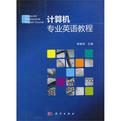计算机专业英语教程
出版时间:2013-1 出版社:科学出版社 作者:柯晓华 编 页数:229 字数:339000
内容概要
《计算机专业英语教程》(作者柯晓华)是以计算机领域的英语文章和国外最新的计算机原版教材为基础编写而成的,内容注重实际应用与教学模式相结合,从而激发学生对计算机专业英语课程学习的热情。作为教材,《计算机专业英语教程》的专业知识涉及信息系统与计算机基础知识、软硬件组成结构、计算机网络的组成及其应用、数据库、数据结构、多媒体技术、信息安全、程序设计和其他深刻影响我们生活的信息技术。本书选材广泛,内容丰富,针对计算机专业英语的应用需求设计许多训练场景,使读者能够快速掌握计算机领域的大量专业英语词汇和相关的语言运用技巧,从而提高课程的实用性。
本书可作为高等院校计算机相关专业(如计算机科学与技术专业、软件工程专业、网络工程专业、电子商务专业、信息管理专业等)的教材,也可作为计算机专业英语培训教材和相关技术人员的自学教材。
书籍目录
Chapter 1 Information Technology and the Third Industrial
Revolution
Introduction
Section A Information Technology
1. Cloud Computing
2. Modern Information Technology Departments
3. Hardware
4. Software
5. Notes
6. Exercises
Section B The Third Industrial Revolution
1. Five Pilla
2. 3D Printing in the Third Industrial Revolution
3. Notes
4. Exercise
Section C Review, Reading,Computer Terms and Exercise
1. Review
2. Supplementary Reading
3. Computer Terms
4. Exercise
Chapter 2 System Unit
Introduction :
Section A System Unit,Electronic Data and Itructio
1. System Unit
2. Electronic Data and Itructio
3. Notes
4. Exercise
Section B Buses, Ports, Slots, and Power Supplies
1. Buses
2. Ports
3. Expaion Slots
4. Power Supplies
5, Notes
6. Exercises
Section C Review and Tralation
1. Review
2. Tralation
Chapter 3 Data Structures
Introduction
Section A Fundamentals and Implementation
1. Data Structure Fundamentals
2. Data Structures Implementation
3. Notes
4. Exercises
Section B Cotructed Data Structures
1. Customized Data Types
2. Classes and Objects
3. Notes
4. Exercises
Section C Review and Grammar
1. Review
2. Grammar
Chapter 4 Computer Progranuning and Its Languages
Introduction
Section A Computer Programming
1. Introduction
2. Different Types of Computer Programming
3. Object-Oriented Programming
4. Programming Style
5. Notes
6. Exercises
Section B Computer Programming Languages
1. History of Programming Language
2. Low-level Programming Language
3. High-Level Programming Language
4. Notes
5. Exercises
Section C Self-evaluation and Review
1. Selbevaluation
2. Review
Chapter 5 Operating Systems
Introduction
Section A Description of Operating Systems
1. General Knowledge of Operating Systems
2. The History of Operating Systems
3. Note
4. Exercise
Section B Components of an Operating System
1. A Software Survey
2. The Shell of an Operating System
3. The Kernel of an Operating System
4. Notes
5. Exercises
Section C Reading and Exercise
1. Supplementary Reading
2. Exercise
Chapter 6 Application Software-Database and Multimedia
Introduction
Section A Database
1. About Database and DBMS
2. Eeatures
3. Applicatio of Databases
4. Database Development Platforms
5. Notes
6. Exercise
Section B Multimedia
1, Introduction
2. The Elements of Multimedia
3. Interactive Multimedia Applicatio
4. Notes
5. Learning Task
Section C Review, Reading and Grammar
1, Review
2. Supplementary Reading
3, Grammar
Chapter 7 Imternet
Introduction
Section, A Internet Communication
1. The History of the Internet
2. Web Basics
3. Accessing the lnternet
4. Notes
5. Exercise
Section B Internet Applicatio
1. Communieation
2. Web Search Engine
3. Electronic Commerce
4. Data Trafer
5. Globalization and the 21st Gentury
6. Notes
7. Exercises
Section C Reading, Grammar and self-evaluation
1. Supplementary Reading
2. Grammar
3. Self-evaluation
Chapter 8 Computer Network
Introduction
Section A Network Software
1. Example Networks
2. Protocol Hierarchies
3. Types of Networks
4. Notes
5. Exereises
Section B Network Hardware
1. Guide
2. Physical Communication Channel
3. Basic Hardware Components
4. Notes
5. Exercise
Seetion C Review and Abstracting
I. Review
2. Writing an Abstract
References
Appendix Common Vocabulary in English for Computer Specialty
章节摘录
版权页: 插图: 1.History of Programming Language A programming language is a set of words, codes, and symbols that allow a programmer to give instructions to the computer. Many programming languages exist,each with their own rules, or syntax, for writing these instructions.Programming languages can be classified as low-level and high-level languages. As the first three modern programming languages (Fortran, Lisp, and COBOL) were developed in the 1950s, programming languages had gone through a big change in the time period from the 1950s to the 1990s, which could be divided by a boundary, the 1990s. From back in the 1950s, 1960s, 1970s and 1980s, programming languages (like BASIC,PASCAL,C,C++) virtually were very complicated and needed to be thinking about the slow and not enough memory of the computer in that time.Since the 1990s, however,with the unprecedented development of PCs and the rapid growth of the Internet in the mid-1990s, developing a language processor has been no longer so complicated like that of before the 1990s, like PHP, JavaScript, Java, Python, C #, etc.Also the Internet created an opportunity for new languages to be adopted. In particular, the Java programming language rose to popularity because of its early integration with the Netscape Navigator web browser, and various scripting languages achieved widespread use in developing customized applications for web servers.Some classical and important programming languages are listed below: Fortran (Formula translation) is the oldest language still in use.Created in 1957 by John Backus, the language was developed to perform high-level scientific,mathematical,statistical computations.Now the language is still used in aerospace, automotive industries,governments, and research institutions.
图书封面
评论、评分、阅读与下载
用户评论 (总计2条)
- 该书有折角,封面有明显褶皱的
- 推荐使用,尤其是多种教学设计和测试设计,能够更好地开展专业英语的学习.
推荐图书
- 外国音乐剧独唱作品选(女声卷)
- 少儿古筝乐曲精选1
- 笙考级曲集(全2册)
- 现代西方音乐哲学导论
- 西方音乐史基础知识100问
- 图说水稻病虫害防治关键技术
- 中西结合兽医宝鉴
- 羊病临床诊疗实例解析
- 茶印千古缘
- 高毒农药替代产品筛选和使用技术研究
- 图解桃树整形修剪
- 肉牛牦牛寄生虫病防治百问百答
- 我国农村居民消费的非收入影响因素研究
- 镇域经济发展战略和路径选择
- 柑橘产业经济与发展研究2011
- 图说千种树木5
- 中国大农业投资分析研究报告
- 中国奶农专业合作社调查研究
- 中国牧草产业经济
- 小学语文三年级(下)
- 渐开线少齿差行星齿轮传动装置
- 商务英语会话速查快说
- 看图学修汽车音响
- 中老年人快捷学电脑与上网
- 学驾驶快乐行
